This is You Asked, a series in which I answer frequently asked questions to help you live your best tech life, and to connect our Digital Trends readership. Sometimes that means going behind the scenes, talking shop, or sharing personal anecdotes.
This week, I’m excited to answer one of the most frequently asked questions I’ve gotten over the 13 years or so I’ve been reviewing tech. I’m not crediting any one person for this question; it’s just the most frequently asked question I get, so I figured I would answer it for everyone. That question usually goes something like:
Why don’t you buy the TVs you review instead of accepting review samples from TV brands?
And then there’s usually a list of proposed advantages to buying the TVs we review at retail, like avoiding golden samples, getting a better feel for what the average consumer deals with, etc.
The reasons we don’t buy the TVs we review — or, for that matter, most of the products we review — are multitudinous. There are so many, in fact, that I had to create an outline so I could present them in some coherent manner. I’ve done the best I can in that regard, and to that end, I can break things down into a few categories.
- Logistics
- Cost and time
- Liability
- Access
- Miscellaneous matters of feasibility
I’m especially fond of that last one.
Logistics
We’ll start with logistics. And under logistics, we have actual logistics — that’s the shipping and receiving involved — plus storage and insurance.
TVs are big. And we have limited space to store TVs. Realistically, our studio space can handle, at most, three TVs and their boxes at a time. You may be wondering, “Well, Caleb, why don’t you just get a storage unit if storage is an issue?” To which I’d say: “Oh, I have one.” I’ll get to that in the time/cost section.
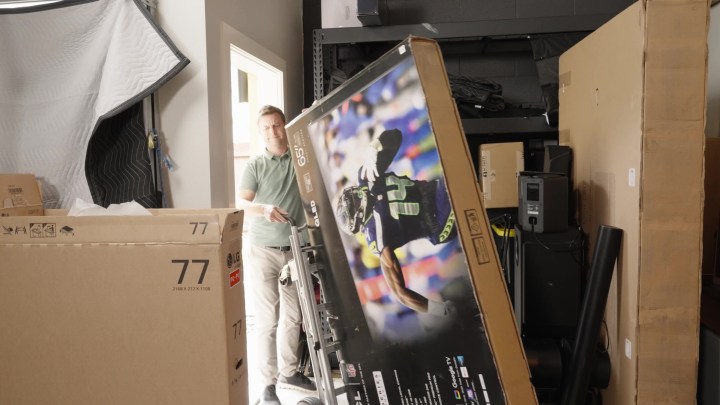
Then there’s the shipping part. Eventually, if we bought these things, but aren’t going to keep them, these TVs need to get shipped somewhere. Who am I going to ship them to? Options could include a secondary buyer or an auction winner, or possibly a charity or contest winner. Who is going to handle that shipment process?
In addition to the challenges associated with shipping TVs out of our studio, there’s the matter of insurance. I’m going to need to ensure that the TV arrives at its destination safely, on time, and in good condition. That means contracting with a logistics company that is not FedEx or UPS, and it means adding insurance. All of that, as you gathered, leads us into time and cost. And under that category, we have the time dedicated to logistics, and the cost of the logistics, as well as the cost of purchasing the TVs and the cost associated with taking a loss for each and every TV we review.
Time and cost
Starting with the time associated with the logistics: We review enough TVs here that we would need a person dedicated just to handling the shipping and receiving of TVs. That means being on the phone with the logistics companies, constantly coordinating the delivery of the TVs, and booking the shipping of outbound TVs and coordinating their pickup, as well as shuttling TVs back and forth to the storage unit — all while carefully timing things such that only the TVs we absolutely must have at the studio are actually in the studio. This would necessarily mean that a TV I don’t actually want to be here would have to be here taking up the space of another TV that I need to have here, even with the careful timing of our dedicated logistics person.
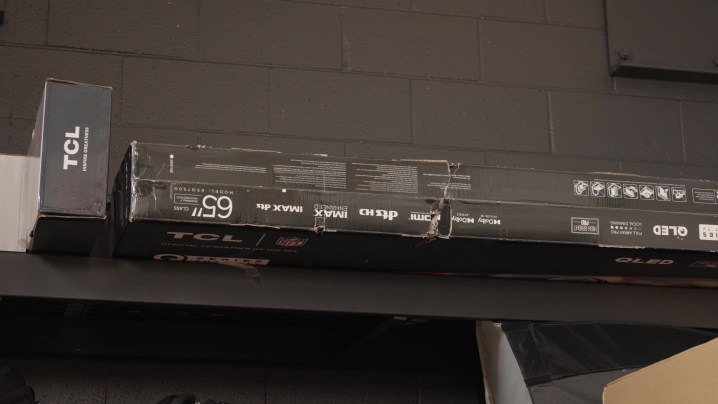
That person would also have to handle all of the processes involved in listing and selling the TV, collecting payments, running an auction and collecting payments, finding a charity, or running a giveaway. All of that is a full-time job, and that costs a not insignificant amount of money, which moves us to costs.
We will have to eat a loss on every TV we buy for review and then sell. Even if I had time to professionally calibrate each TV as a value-add on the sale to help minimize loss, that’s not legal for me to do, and I don’t have the time to do that. In addition to eating the loss on the cost of the TV, we have to support the cost of shipping every outbound TV — which is no small amount because we’re talking about shipping a lot of large, heavy objects around. Plus, we have to pay for the insurance to make sure that if it doesn’t arrive in good shape, the cost of the TV is covered and can be replaced. Also, there’s time involved in replacing the TV. And there are costs associated with shuttling the TVs around locally to and from our storage unit.
Conservatively, we are looking at no less than $85,000 a year. Never mind all the headaches that will arise when something goes wrong. Also, as the seller of the TV, there’s inherently an expectation that we are going to have the time to somehow support the sale or help troubleshoot issues. But we aren’t Best Buy or Value Electronics, and we simply can’t offer that service.
To all of this, you might say: Rtings and Consumer Reports do it: Well, we aren’t Rtings or Consumer Reports. We have a completely different business model. And I might point out that business models like Rtings and Consumer Reports are very much in the minority, and there’s a good reason for that.
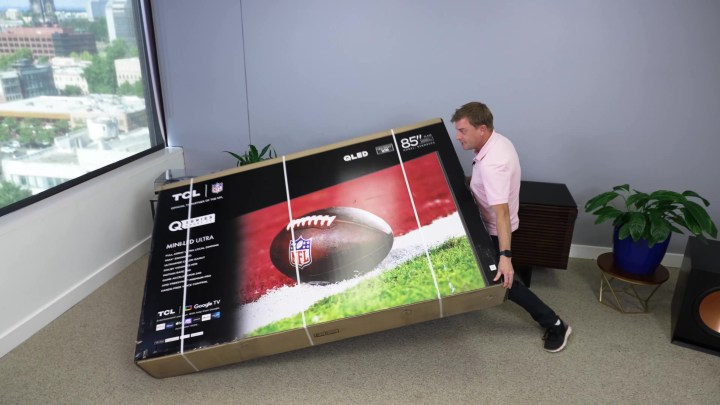
But beyond the business model considerations, this job of pulling in many, many TVs per year and then making them disappear is only feasible for us when all the logistics and costs are handled by the TV brands. They have it built into their budgets. That’s why review samples are a thing, and why the vast majority of publications participate in reviewer programs.
Oh, one more cost I forgot to mention: Insurance for us. Our studio and storage unit are covered up to a certain amount. The more TVs we have sitting around, the more risk we take on if there is theft, fire, or some other cataclysmic event. If something bad were to happen, we’d take a big hit.
Liability
The next category is liability — and I already covered some of this in terms of the liability involved in making sure a TV arrives in good shape, the expectation that we service a sale like a retailer, and the liability of loss due to a tragic event. There’s also liability involved with Uncle Sam. We are not an authorized retailer or reseller of consumer electronics. Once we pass a certain threshold, we are treading into legal hot water. We have a lawyer on staff at Digital Trends, but this kind of thing is not in their purview, and it can’t be.
Access
Frankly, all of that is reason enough that we can’t buy our TVs at retail. But there are some access considerations as well. By access, I mean a few different things. First, and possibly foremost, is that I can often get products sooner than they are available at retai. That changed for a little bit during the pandemic when logistics became a nightmare for everyone, but it’s been returning to normal.
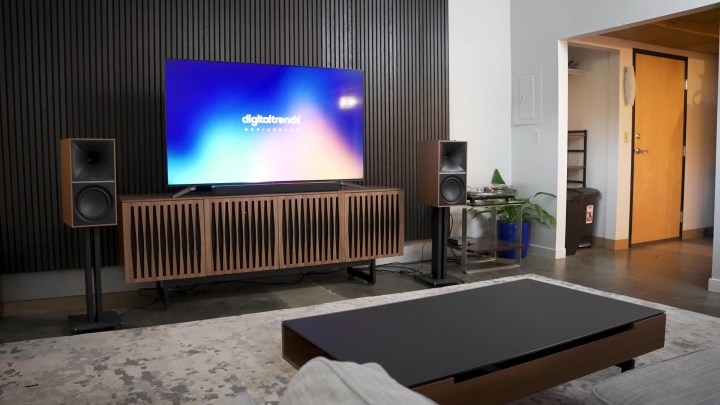
Obviously, I’m interested in getting products as soon as I can to provide timely reviews. But also, by developing an open dialogue with TV brands, getting briefings so I can understand their technology better, and being able to provide those brands with feedback on their products, there are multiple benefits. For one, I can get questions on deep technical questions answered quickly. I have access to the engineers who designed this stuff. I have access to the manufacturing facilities that put it together. I can get information a lot of other folks can’t. Second, I can also provide feedback to these companies that make their products better by the time they do reach store shelves — this is a big part of why firmware updates come quickly and fix problems before or soon after TVs land in people’s homes.
I say what I want to say, and that’s it.
Finally, We’re seeing an increasing number of TVs that won’t get shipped to any reviewers. In those cases, TV brands will host reviewer workshops where I and other journalists can get some one-on-one time with the TVs that are just too big or too expensive to ship. In some cases, that’s the only way we’d be able to review them — unless we bought them and waited for them to arrive, but that takes us back to the points I made earlier. And the stakes are way, way higher with a $30,000 TV than they are with a $5,000 TV.
Now, I can understand if folks feel like this sort of quid pro quo relationship must mean that TV brands get some kind of influence over editorial content. Let me be clear: They do not. And they know that. And most of them know not to try. The folks I deal with have been at this reviewer program thing for a long time. They know my editorial commentary is not for sale. They can’t ask me to say something or not say something. I mean, they can ask, but ultimately, I’m going to say no. I say what I want to say, and that’s it. That’s why none of my reviews will ever be sponsored, and why sponsored content is clearly labeled as such and we don’t try to pass it off as a review.
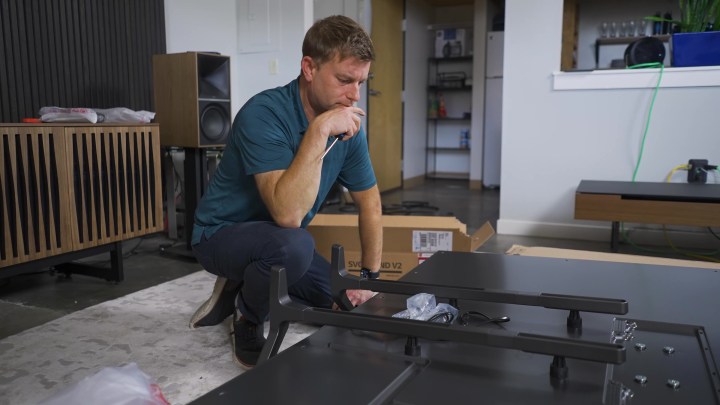
That can not be said for some other publications, and it definitely can not be said for so-called “influencers” who will 100% try to pass off paid content as editorial content. The teams that work with influencers are very different than the teams that work with journalists. Unfortunately for me, that means sometimes they get stuff before I do or even get stuff that I won’t get. But I’m OK with that, because those instances are few and far between, and my editorial content doesn’t get compromised.
Feasibility matters
There are other general feasibility issues in terms of editorial content. If I get to buy all the products I review, then all the other editors should get to do the same, right? And if it’s not tenable for me alone, it’s certainly not something that can be supported across the entire publication. TVs aren’t the only expensive products we test here. Think computers, for starters.
There’s also the hard fact that, even with dedicated people handling logistics, it’s unlikely we could keep up with the publishing schedule we want to maintain. Also, consider that reviewing TVs is not all that I do. I review lots of other tech products, I do public speaking, I cover trade shows and other events, I do guest spots on TV and radio programs — I need TVs to be here when I need them to be here and gone when I need them gone, no delays. It’s tough enough as it is with TV brands handling the logistics.
Oh, and I want to address the question of why I don’t just buy and then return the TVs. Because I get to buy and return a TV twice before I get blacklisted, and that’s if someone doesn’t figure out who I am and what I’m up to at the start. Amazon, B&H, Best Buy, Target, Crutchfield — I mean, I’d burn all of those up in one year.
And that’s the other part of this. I do stuff at a scale that only other large publications do. I review a lot of TVs and other products as well. I don’t have the opportunity to borrow and return TVs because I would destroy someone’s business if I did that.

Finally, I want to address the notion that I’m always going to receive so-called Golden Samples and that my experience will be drastically different than that of general consumers. First of all, not every TV that gets here is a golden sample. I’ve received some TVs that did not have very good screen uniformity or were riddled with DSE, as well as TVs where the processor just didn’t behave correctly. It happens, and I report it.
I think there’s this notion that — I’ll just use TCL as an example because I think its TVs are familiar and at the front of mind for a lot of folks right now — a Golden Sample Q7 might be as good as the worst retail example of a QM8, the model just above it. That’s just not true. The margin of performance difference between retail examples of one model is not enough to offset the performance difference between two different models.
Also, I just want consistency. I’d like to see the best example of a TV’s capable performance and compare that to the best example of another TV’s capable performance, thus leveling the playing field for these TVs. The level is high, but it is level, and that’s what matters to me.
Editors’ Recommendations
Credit: Source link


Comments are closed.